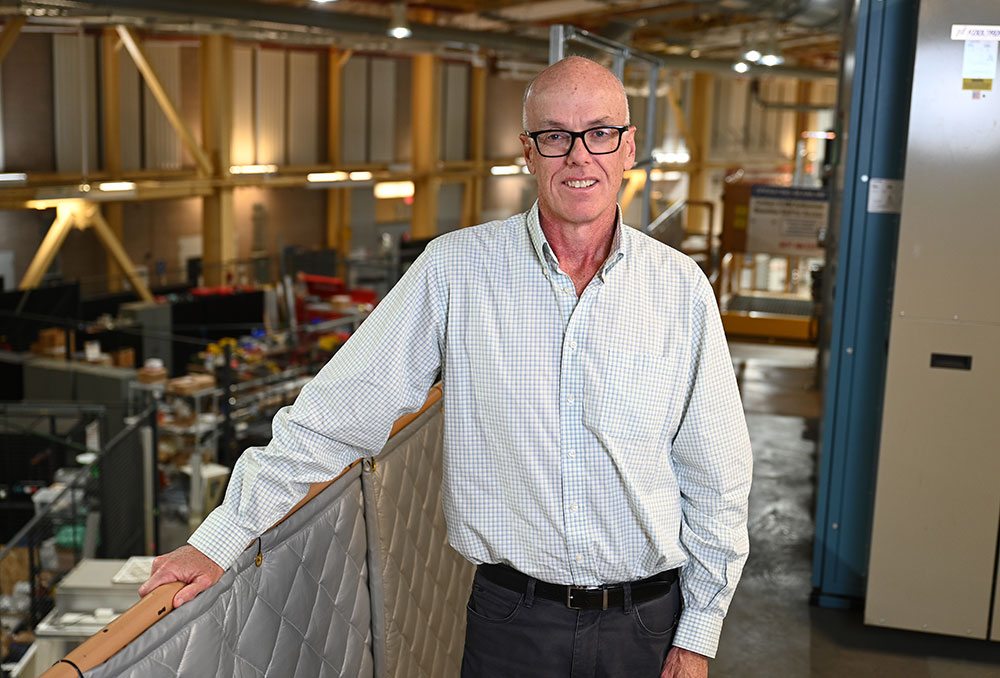This year, FEMA celebrates a 20-year partnership with the U.S. Department of Energy’s (DOE) Argonne National Laboratory. The relationship has played a pivotal role in advancing the practice of emergency and disaster management. Argonne, a thriving hub of scientific discovery and technology research and development just southwest of Chicago, provides world-class data, analysis and expertise that benefit communities throughout the nation.
“For 20 years, Argonne has extended its scientific expertise to FEMA’s mission of helping people before, during and after disasters. Our scientists work beyond traditional lab settings to help deliver assistance to communities in need.” — Laboratory Director Paul Kearns
Its expertise in decision and infrastructure sciences, as well as state of the art DOE Office of Science user facilities like the Argonne Leadership Computing Facility, provide FEMA with the world-class resources that are needed to enable strong decisions when they are needed most.
The collaborative relationship has helped FEMA change its approach to preparing for, mitigating, responding to and recovering from disasters.
“FEMA is always ready to assist communities in the response and recovery phases in disasters, but we also want to help communities adapt to and withstand future challenges,” said Deanne Criswell, administrator of FEMA. “Our strong partnership with Argonne empowers us to share resources that improve communities’ ability to shape their necessary response to emergencies, and also address the underlying factors and indicators that affect their overall preparedness.”
Laboratory Director Paul Kearns said Argonne’s support of FEMA reflects its deep commitment to strengthening national security and prosperity.
“For 20 years, Argonne has extended its scientific expertise to FEMA’s mission of helping people before, during and after disasters. Our scientists work beyond traditional lab settings to help deliver assistance to communities in need,” Kearns said. “I look forward to seeing how our collaboration continues to accelerate the development of new technologies that make our country more resilient.”
Science supports emergency management
According to Kyle Pfeiffer, director of research and development for Argonne’s Decision and Infrastructure Sciences division, the role of emergency managers has evolved over the past two decades. They are tasked with thinking through traditional disasters, such as wildfire or flooding, but also emerging issues such as the opioid crisis, unaccompanied minors at the southern border, pandemic response, civil unrest, climate change and cybersecurity.
To address this broad and ever-changing landscape, FEMA and Argonne jointly developed Argonne’s National Preparedness Analytics Center (NPAC). Pfeiffer served as its first director. The center uses data and science to help the nation prepare for, mitigate, respond to and recover from the threats and hazards that pose the greatest risk to the security and resilience of communities in the United States and around the globe. It stands on multiple pillars — planning guidance, modeling, technical assistance, exercise development and crisis communications — that support modern emergency management.
“Our objective is for NPAC to partner with governments, industry, nonprofits and academia to develop and apply innovative solutions to strengthen national preparedness and resilience,” said Argonne’s Iain Reed Hyde, current NPAC director. “Our work ranges from doctrine development and implementation to planning and post-disaster field work.”
For example, FEMA, Argonne, and other emergency management partners developed and refined a key piece of guidance together: the Comprehensive Preparedness Guide 101 (CPG 101). The document provides guidance on the fundamentals of planning and developing emergency operations plans.
“CPG 101 has become a core resource for the emergency management community,” Hyde said. “If a university is offering an emergency management degree program, it’s highly likely those students are learning the CPG 101 six-step planning process.”
Through NPAC, FEMA and Argonne have also collaborated on the development of other technical assistance and planning guidance for communities on topics ranging from climate adaptation to cyber incidents to alert and warning. Supply chain considerations, public-private partnerships and the role of local elected and appointed officials have also been covered in NPAC’s offerings. FEMA and Argonne are currently collaborating on several other products, including development of national resilience guidance, which aims to help everyone understand and fulfill their critical roles related to increasing national resilience.
Examples of award-winning foundational models and tools developed by Argonne include the Resilience Analysis and Planning Tool (RAPT) and the Climate Risk & Resilience Portal (ClimRR). When developing ClimRR, the team used dynamic downscaling to produce high-resolution climate models on a scale of 12 km blocks. Dynamic downscaling refers to using atmospheric physics- and chemistry-based models to dynamically extrapolate future regional climate, in order to produce high-resolution, “neighborhood” scale projections.
Providing access to multiple layers of powerful data and geographic information systems mapping tools, RAPT is an online portal that has more than 100 preloaded layers including community resilience indicators from peer-reviewed research, the most current census demographic data, infrastructure data, and data on weather, hazards and risk. Free online tools like ClimRR and RAPT help communities understand and address their risks and strengths and identify useful hyperlocal data that they can use to develop resilience to improve future outcomes.
Ken Buell, deputy director for response and recovery at DOE’s Office of Cybersecurity, Energy Security, and Emergency Response, said the value of recovery and resilience information at the earliest stages of disaster response — when things tend to move fast and decisions get made quickly — has been a game changer.
“It used to be a linear approach; first, the response, then the recovery,” Buell said. “Now, we see recovery teams involved at the very beginning. If that wasn’t the case, some great ideas wouldn’t be useful anymore because the decisions would have already been made.”
Field Work
Following a disaster, community leaders must quickly restore normalcy for constituents while also using the recovery process as an opportunity to build back better and increase resilience to future disasters. Argonne provides valuable data and analysis to decision-makers to help them accomplish these goals and enhance community capabilities.
For example, many different agencies are often called upon during disaster response and recovery. Each has its own perspective on the impacts of the disaster and this can limit emergency management effectiveness and efficiency. Argonne has worked with FEMA to advance the field by serving as a single source of truth and by putting multiple streams of data into centralized forms. This can provide a common reference point from which to understand underlying factors when making decisions or just digest the scale of what has happened.
“Argonne’s analysis can take into account the economy, housing stock, people and the environment,” Hyde said. “In some cases, such as after a wildfire, our work is fairly broad. We might look at what happened to the forests, to people and to the economy, or we might do modeling of watershed debris flow and how risks changed. In other cases, such as after an island emergency, our analysts might focus on housing and the rental housing market.”
Communities know they can turn to FEMA for assistance after disasters such as hurricanes, tornadoes, floods and wildfires. These efforts are among FEMA’s most public-facing work. FEMA identified 2024 as the Year of Resilience to emphasize that communities that engage in resilience activities respond and recover faster from disasters. FEMA and Argonne plan to use their partnership to grow awareness among community planners and decision-makers to show the benefits of resilience planning and development. Resilient communities who prepare for all hazards and adapt early to changing conditions, can fortify and protect their important resources well in advance of disaster.
Argonne is ready to contribute to FEMA’s efforts as needs arise.
“The first decade, we worked with FEMA on smaller projects related to all-hazards planning,” Pfeiffer recalled. “The past 10 years have been more research, advanced analytics and operations support. The work has evolved almost every year as the emergency management profession has changed. And, because of Argonne’s multidisciplinary portfolio, we have been able to augment areas where FEMA has been growing. There is even more Argonne can do in the years ahead.”
The Argonne Leadership Computing Facility provides supercomputing capabilities to the scientific and engineering community to advance fundamental discovery and understanding in a broad range of disciplines. Supported by the U.S. Department of Energy’s (DOE’s) Office of Science, Advanced Scientific Computing Research (ASCR) program, the ALCF is one of two DOE Leadership Computing Facilities in the nation dedicated to open science.
Argonne National Laboratory seeks solutions to pressing national problems in science and technology by conducting leading-edge basic and applied research in virtually every scientific discipline. Argonne is managed by UChicago Argonne, LLC for the U.S. Department of Energy’s Office of Science.
The U.S. Department of Energy’s Office of Science is the single largest supporter of basic research in the physical sciences in the United States and is working to address some of the most pressing challenges of our time. For more information, visit https://energy.gov/science.



